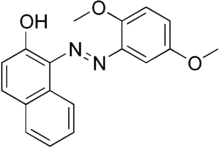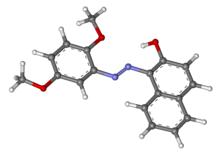 | |
 | |
| Names | |
|---|---|
| IUPAC name 1-(2,5-Dimethoxy-phenylazo)-naphthalen-2-ol | |
| Other names Citrus Red No. 2, C.I. Solvent Red 80, C.I. 12156, E121 | |
| Identifiers | |
3D model (JSmol) | |
| ChemSpider | |
| ECHA InfoCard | 100.026.162 |
| E number | E121 (colours) |
| KEGG | |
PubChem CID | |
| UNII | |
CompTox Dashboard (EPA) | |
| |
SMILES
| |
| Properties | |
| C18H16N2O3 | |
| Molar mass | 308.337 g·mol−1 |
| Appearance | Orange to yellow solid or a dark red powder |
| Melting point | 156 °C (313 °F; 429 K) |
| Insoluble | |
| Hazards | |
| NFPA 704 (fire diamond) | |
Except where otherwise noted, data are given for materials in their standard state (at 25 °C [77 °F], 100 kPa). | |
Citrus Red 2, Citrus Red No. 2, C.I. Solvent Red 80, or C.I. 12156 is an artificial dye. As a food dye, it has been permitted by the US Food and Drug Administration (FDA) since 1956 to color the skin of oranges.[1][2][3] Citrus Red 2 is listed by the International Agency for Research on Cancer (IARC) as a group 2B carcinogen, a substance "possibly carcinogenic to humans".[4]
Properties
Citrus Red 2 is an orange to yellow solid or a dark red powder with a melting point of 156 °C. It is not soluble in water, but is readily soluble in many organic solvents.
Use
In the United States, Citrus Red 2 is sometimes used to color oranges. It is only permitted to be used on the peel.[1] It is permitted when the fruit is intended to be eaten, but is not permitted when the fruit is intended or used for processing, for example to manufacture orange juice.[2] It is used on some oranges from the US state of Florida but is banned in the US states of California and Arizona.
References
- ^ a b Anonymous. 1988. Florida Citrus Fruit Laws. Florida Statutes. 601.
- ^ a b "Code of Federal Regulations: Title 21, Section 74.302". U.S. Food and Drug Administration. Retrieved 20 May 2014.
- ^ Hall, David J (1989). "Peel Disorders of Florida Citrus as Related to Growing Area and Color-add formulations". Proc. Fla. State Hort. Soc. 102: 243–246.
- ^ Agents Classified by the IARC Monographs Archived 2011-10-25 at the Wayback Machine, IARC
